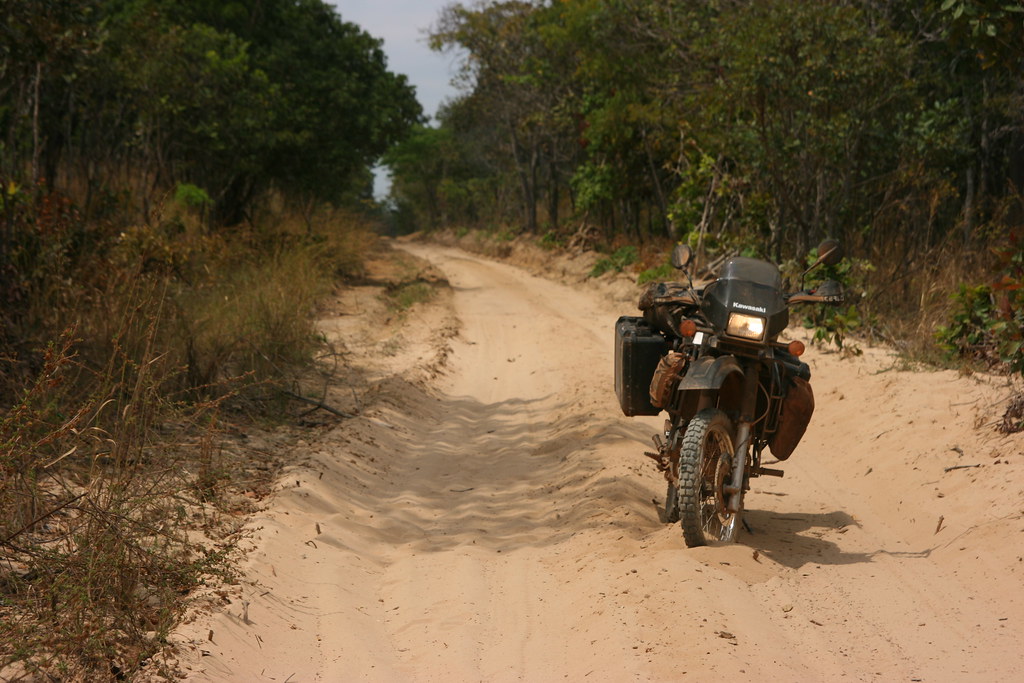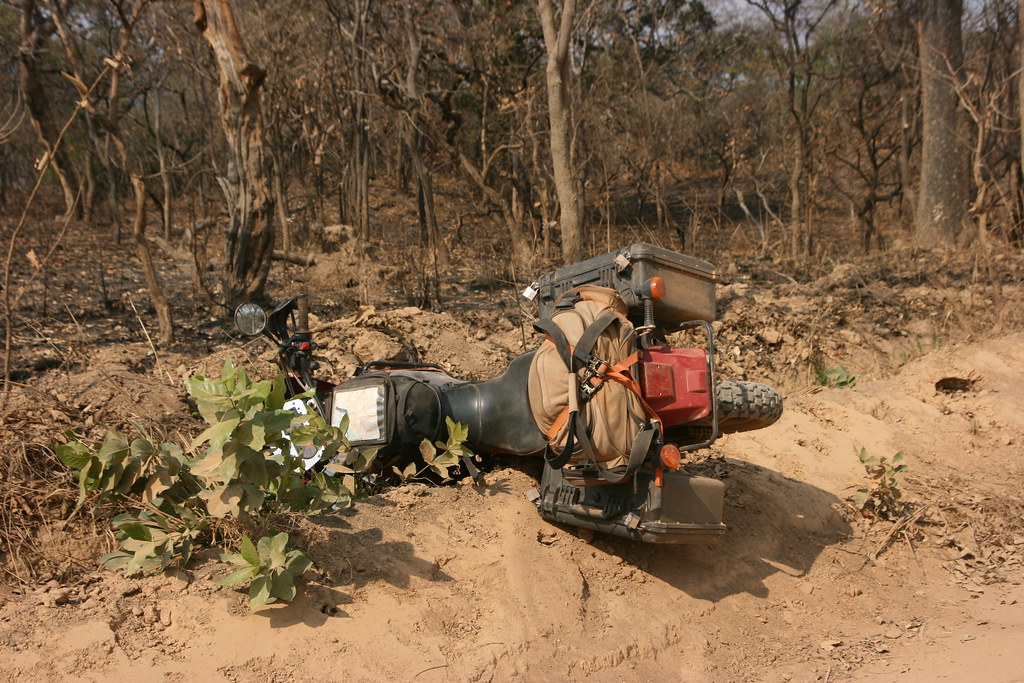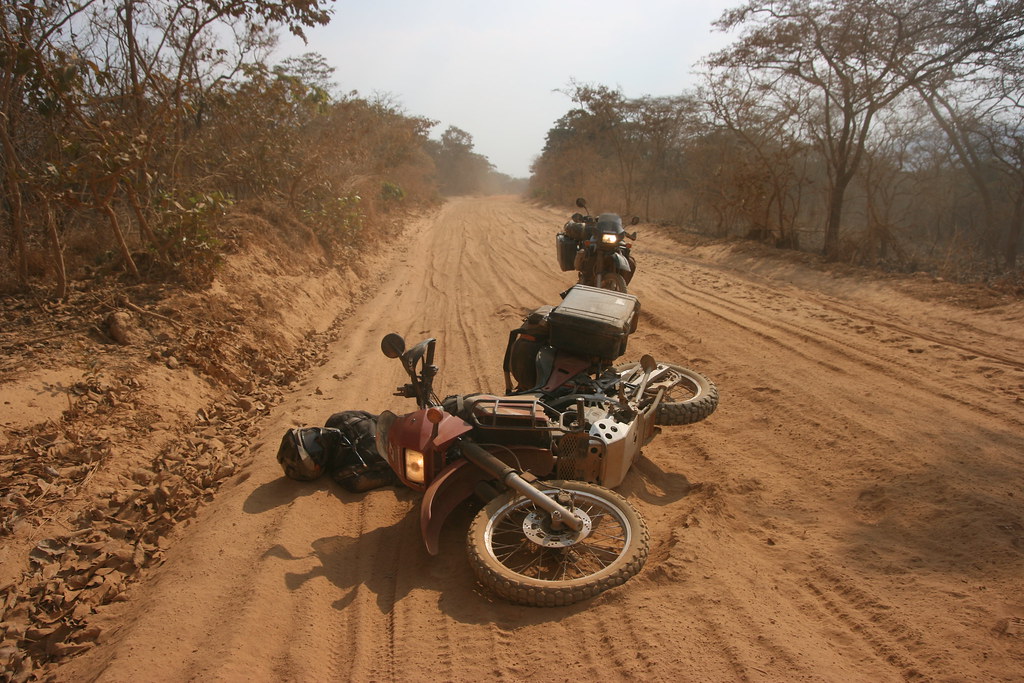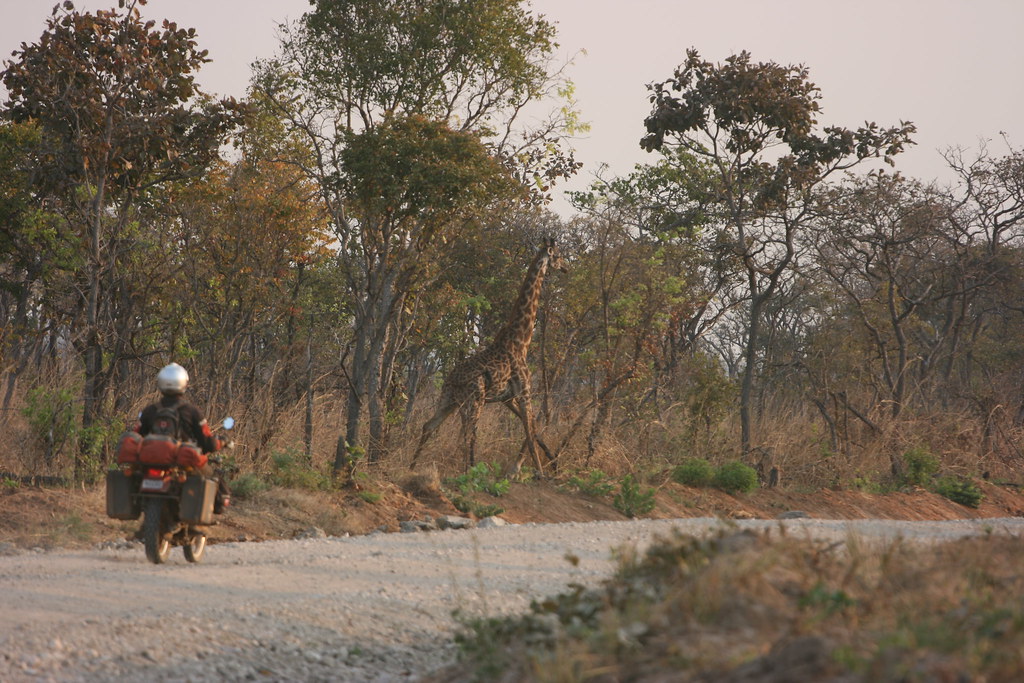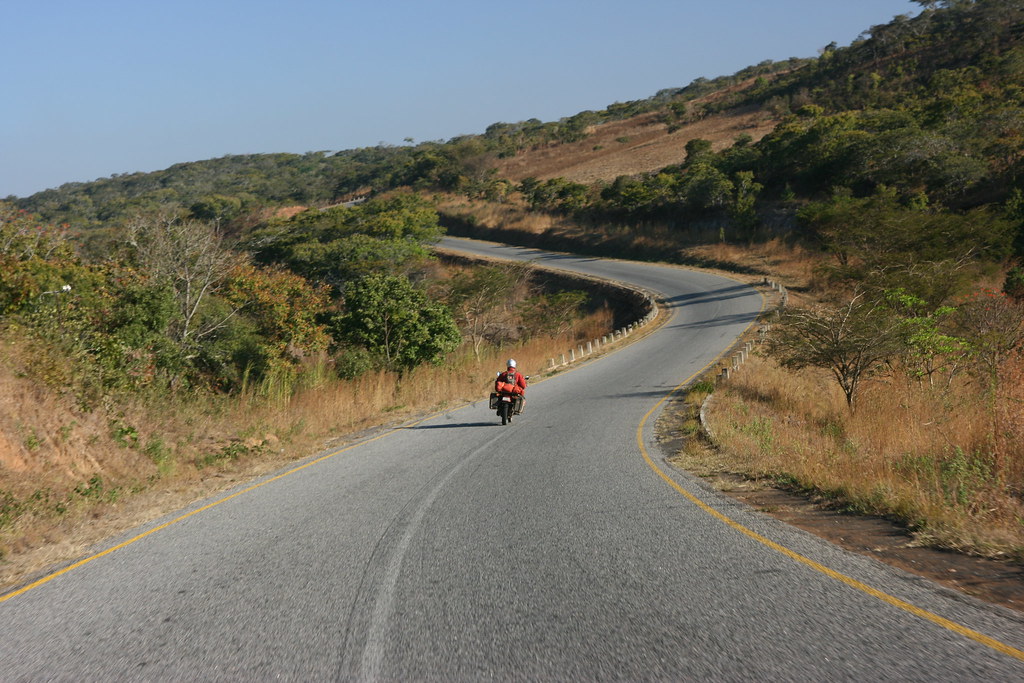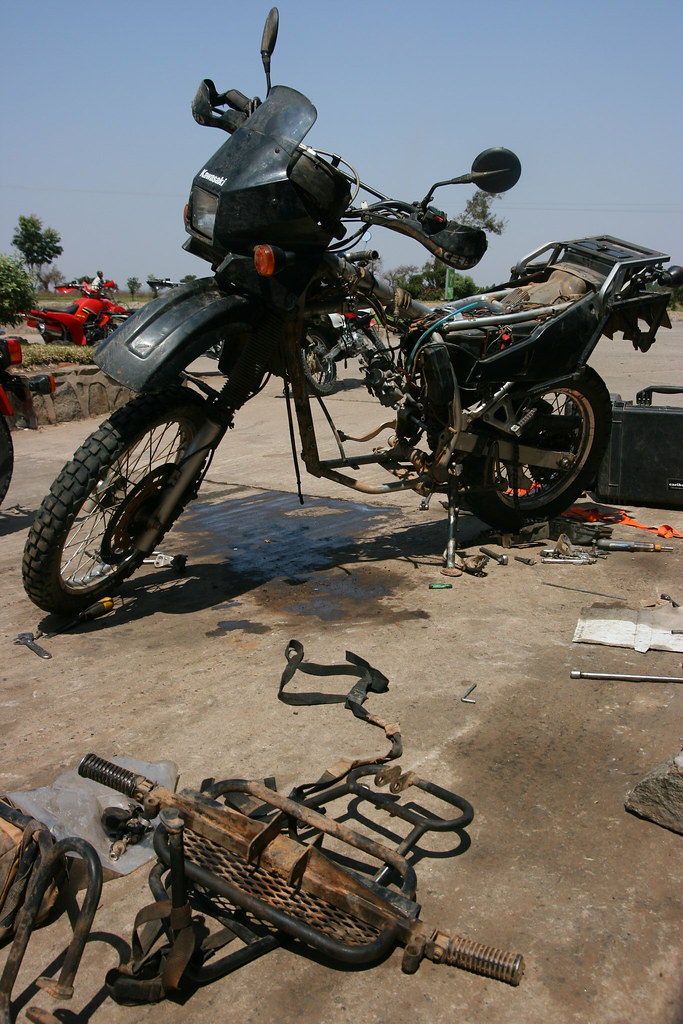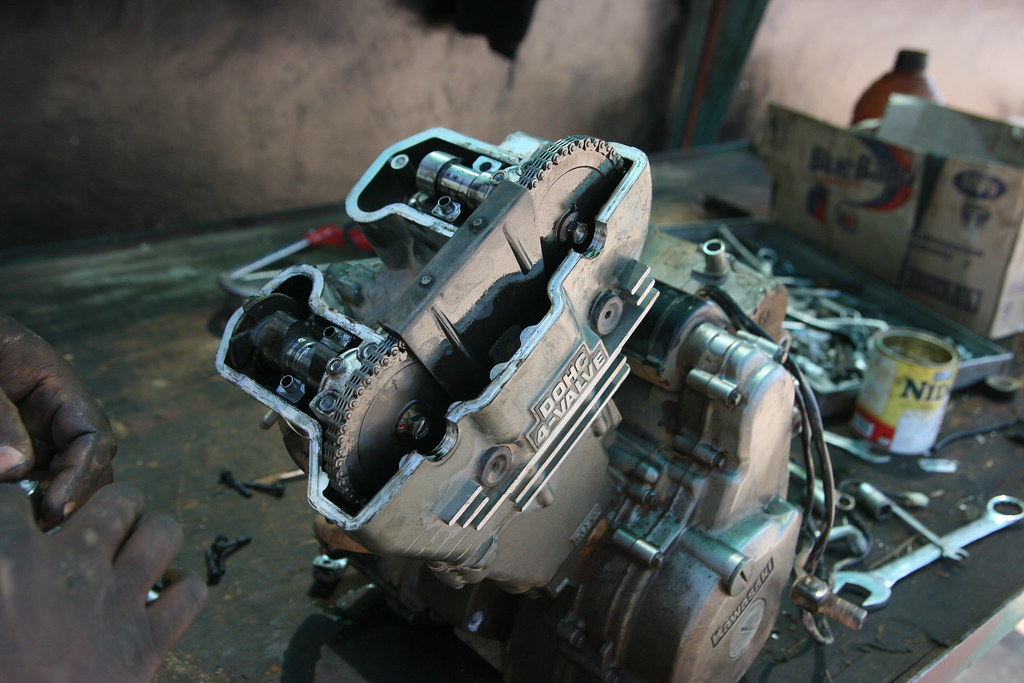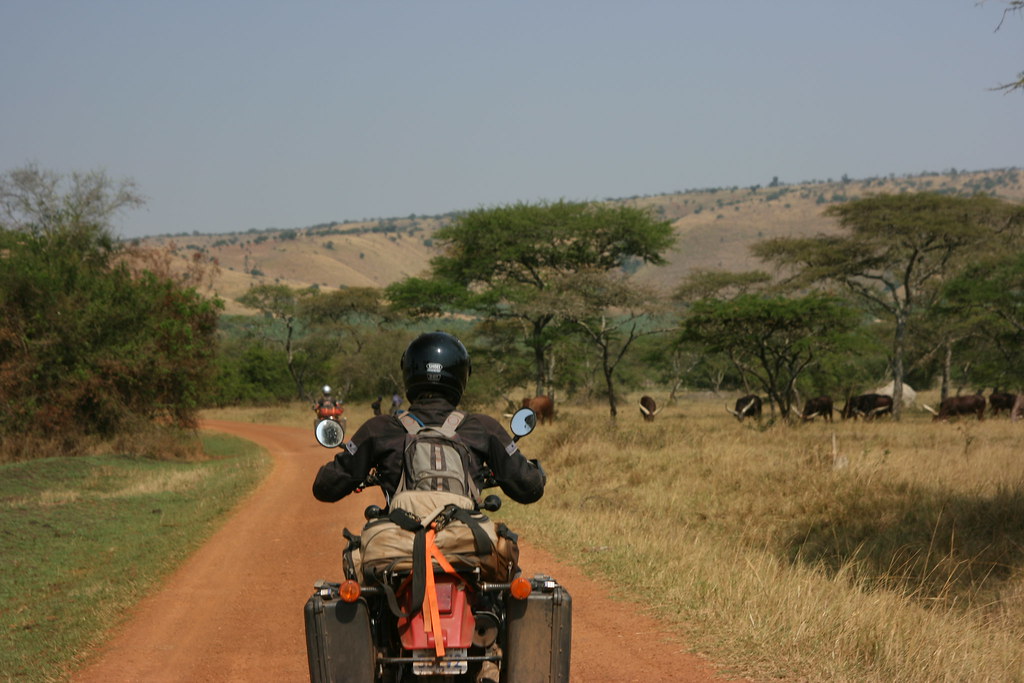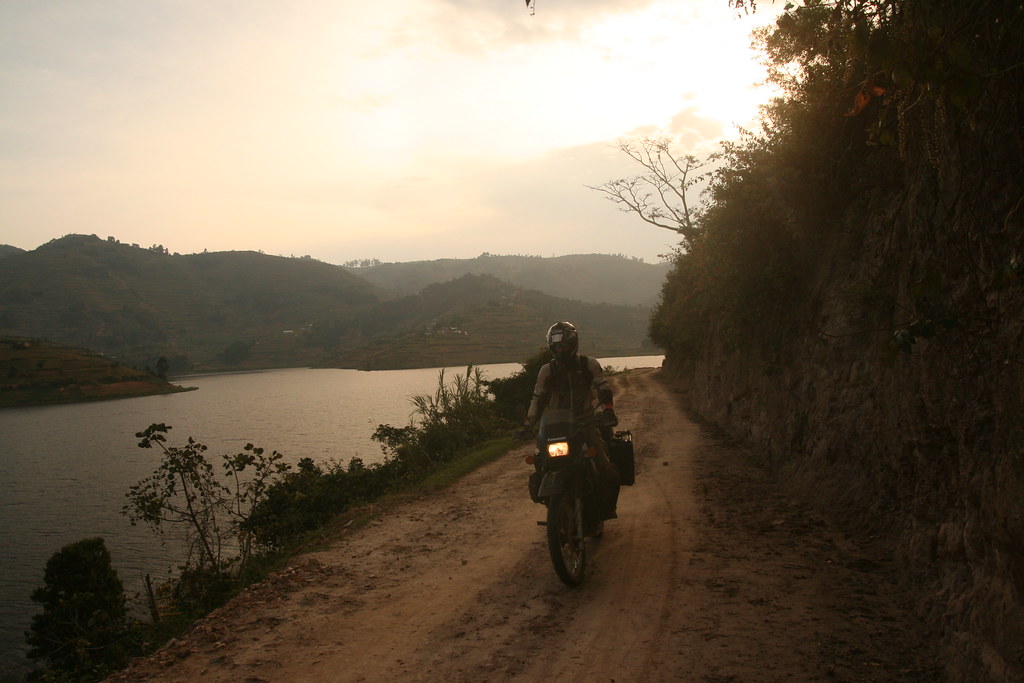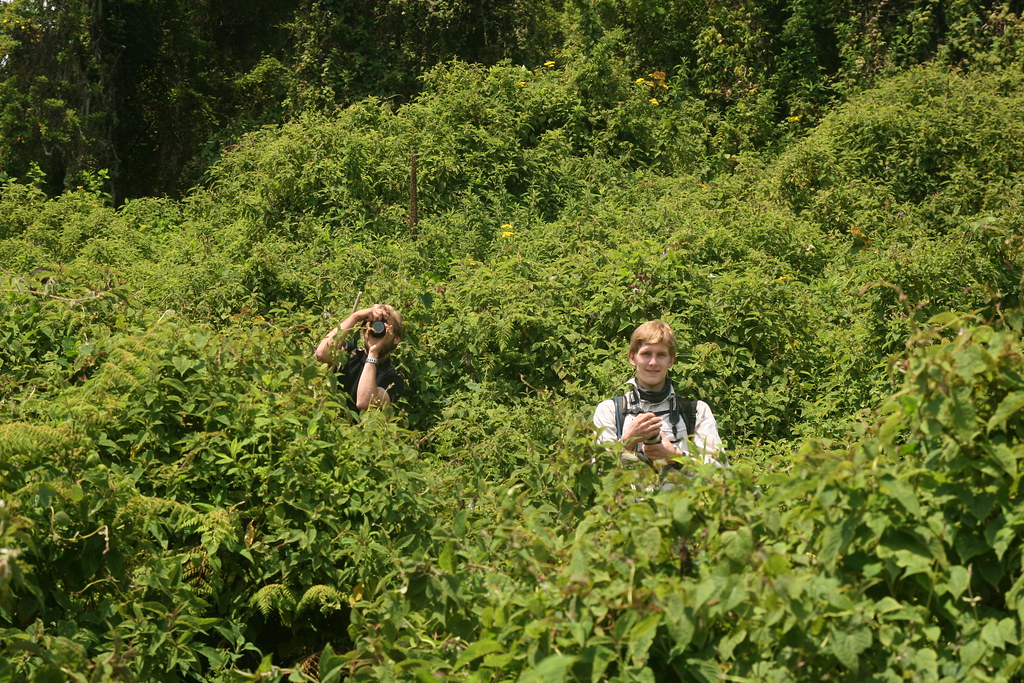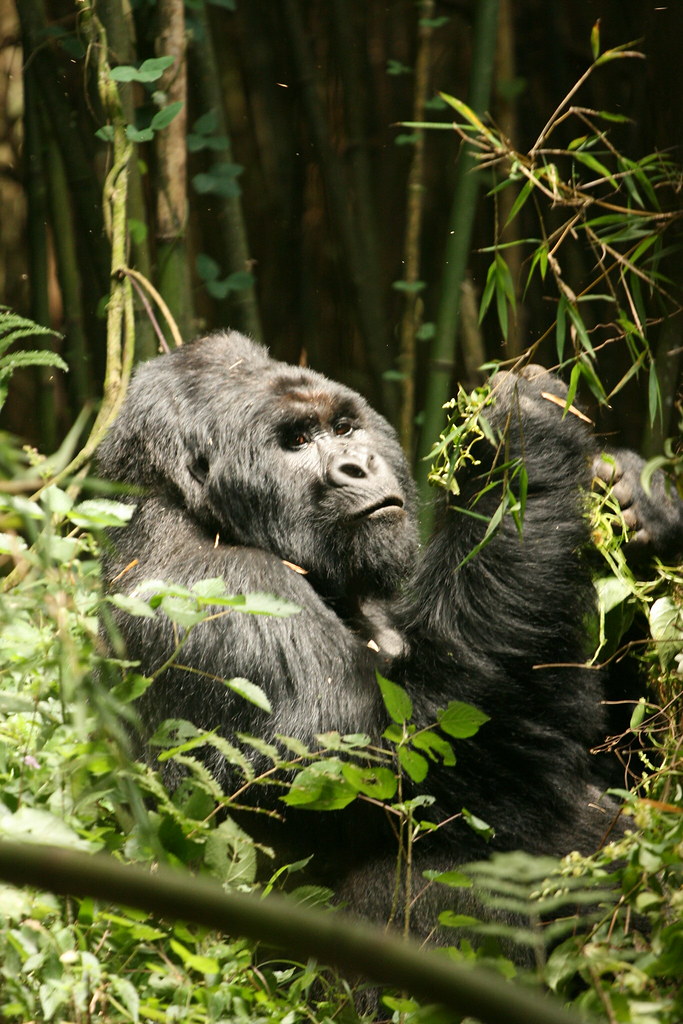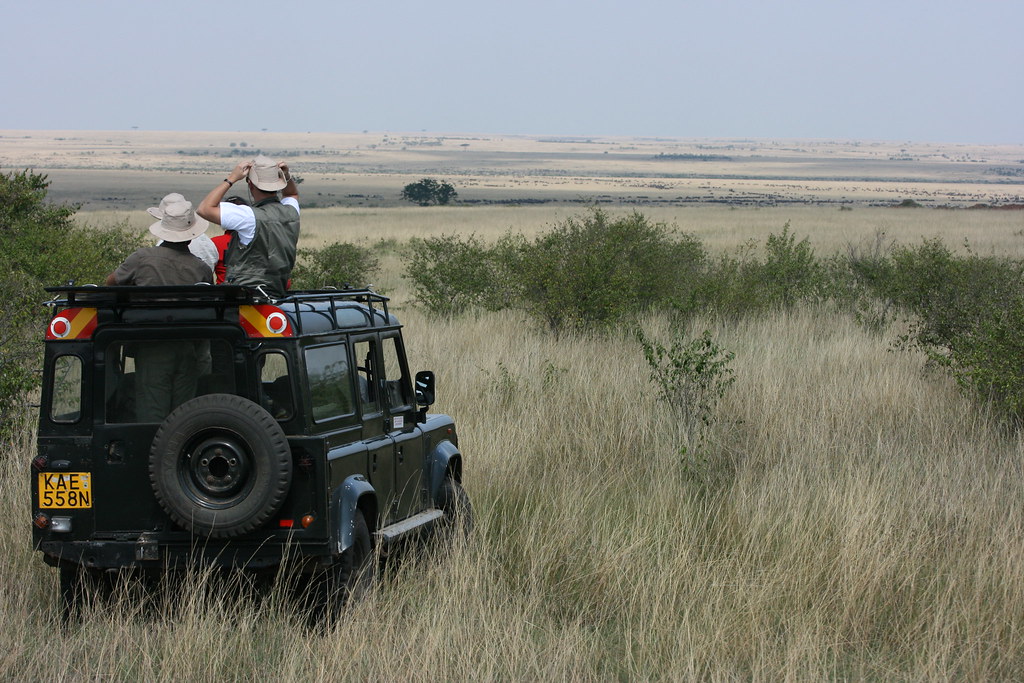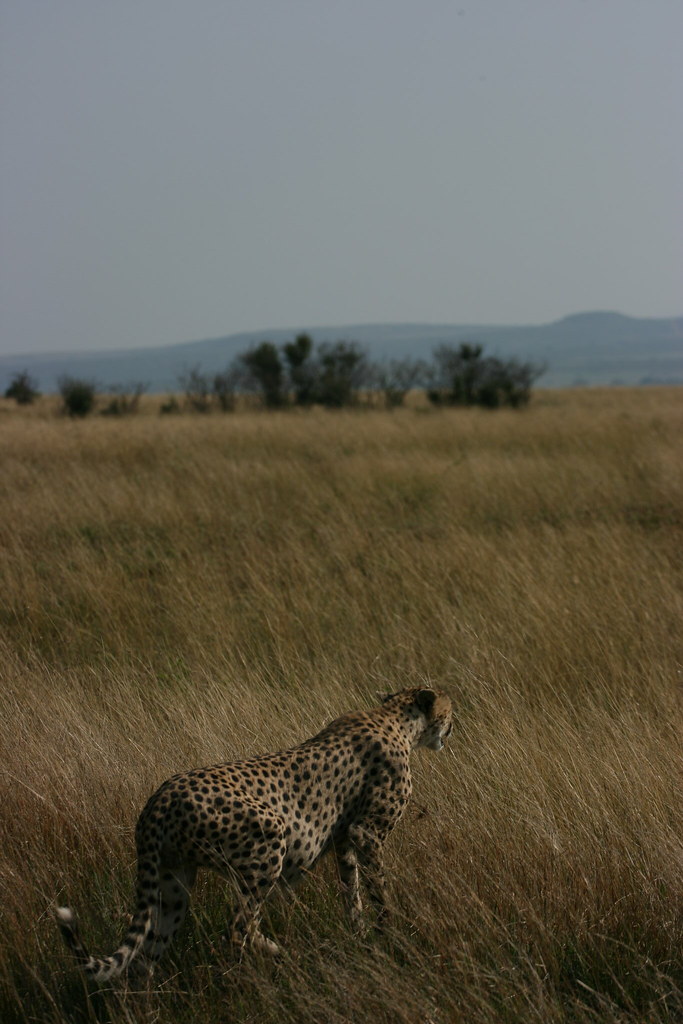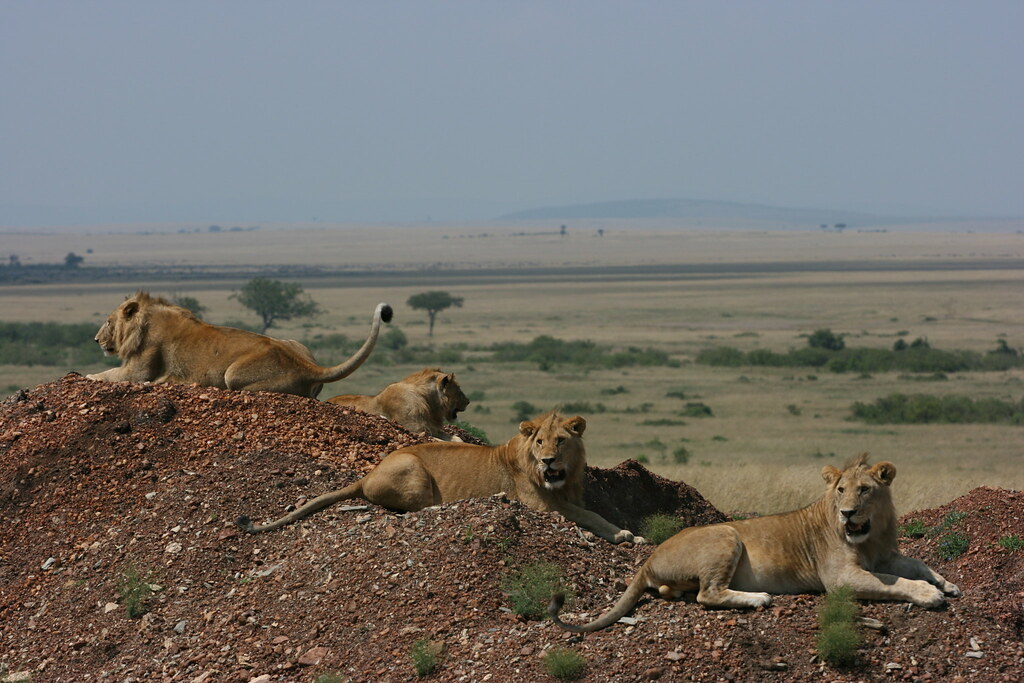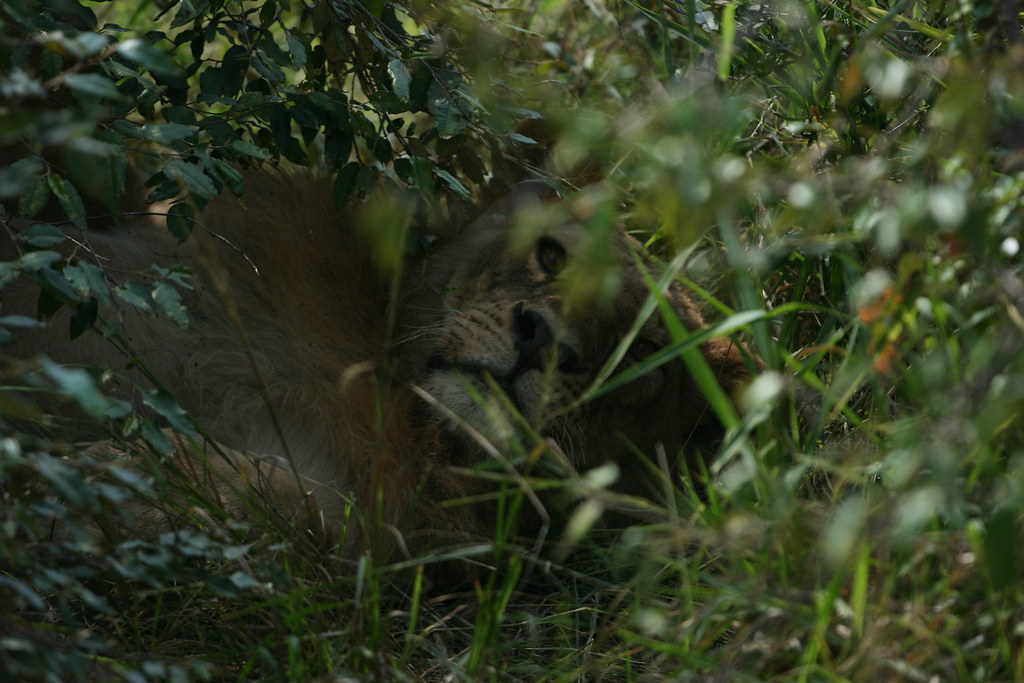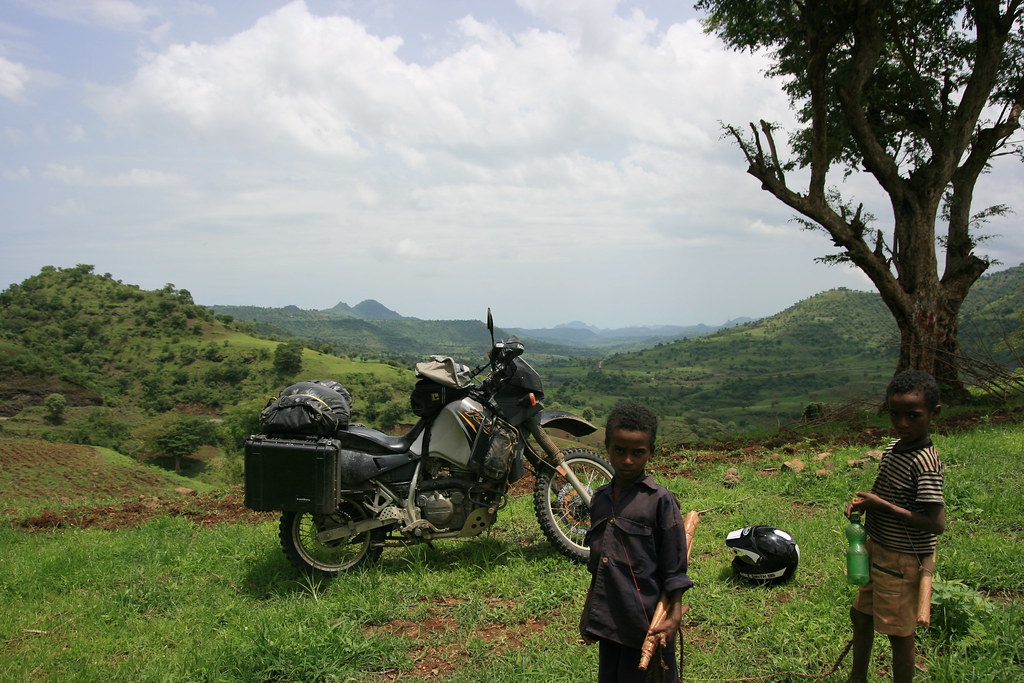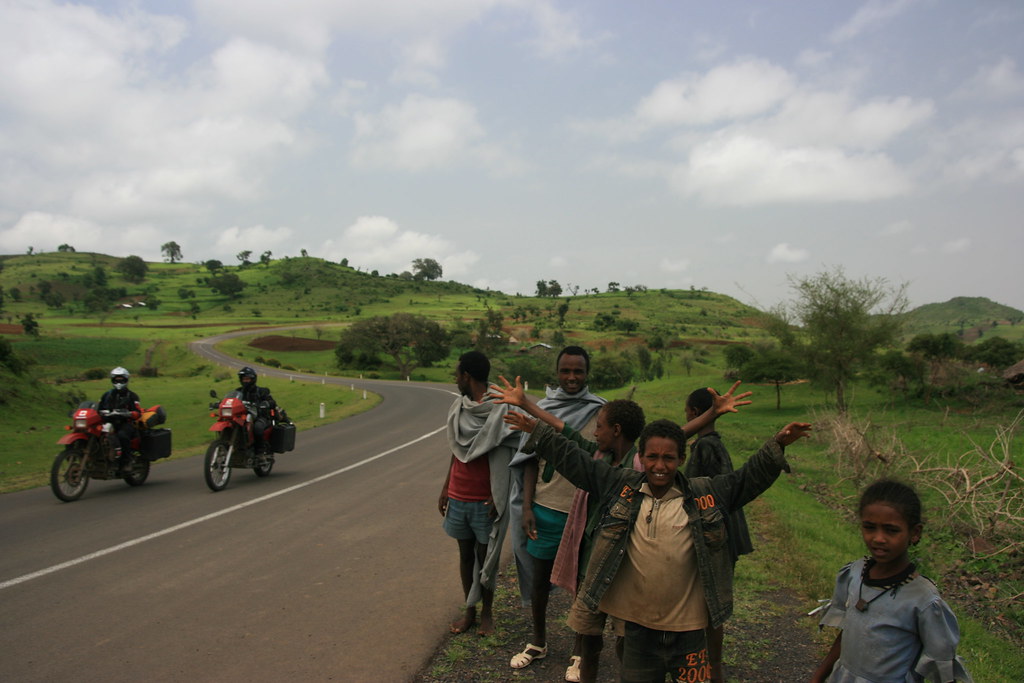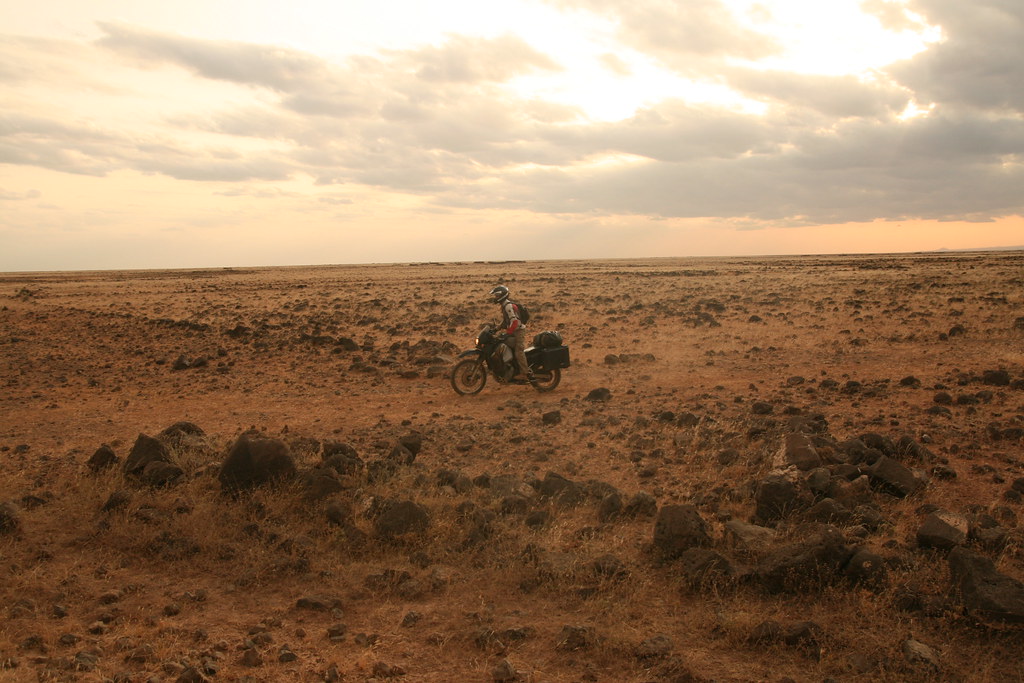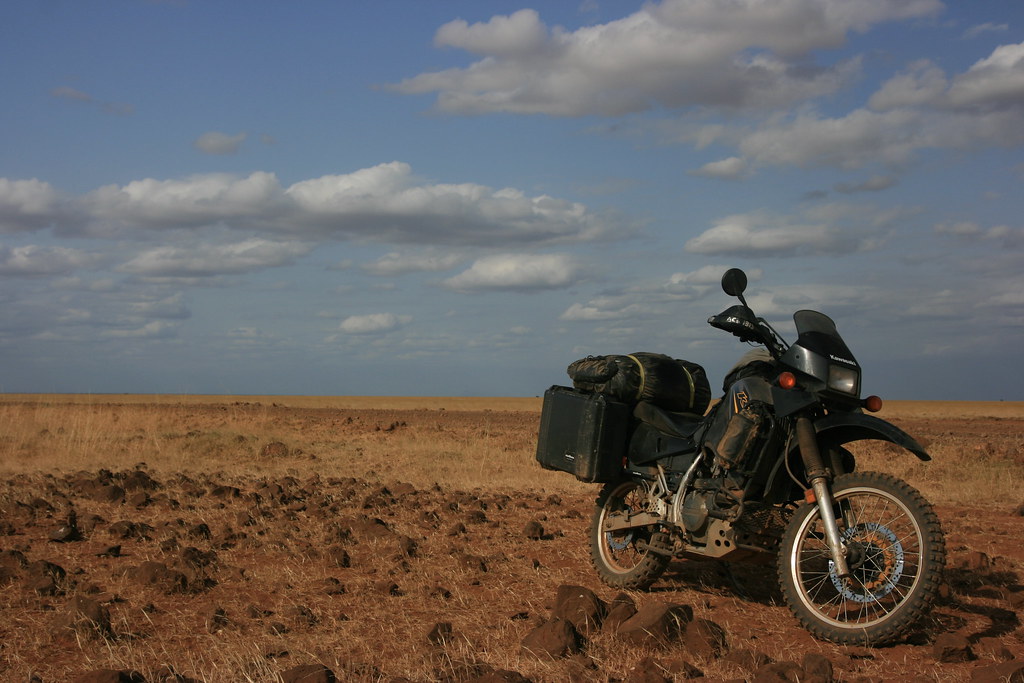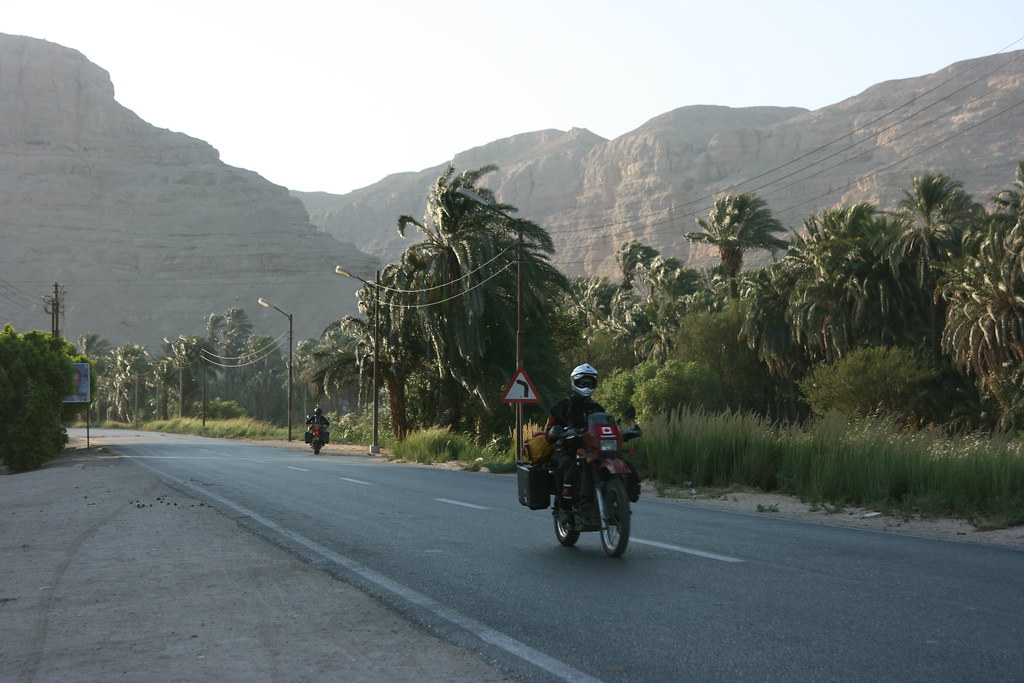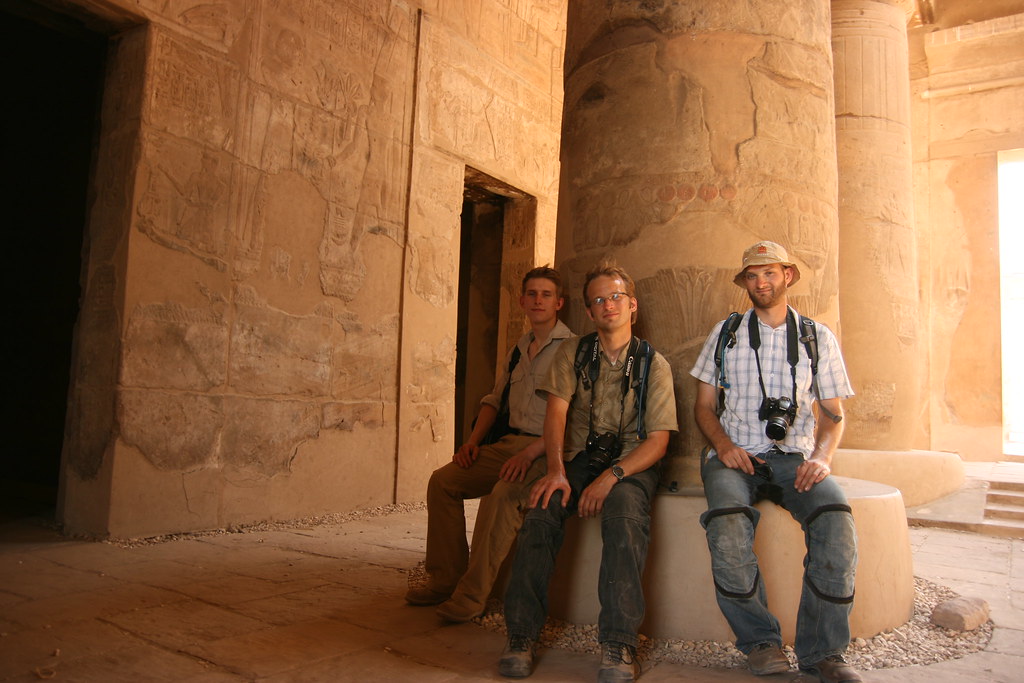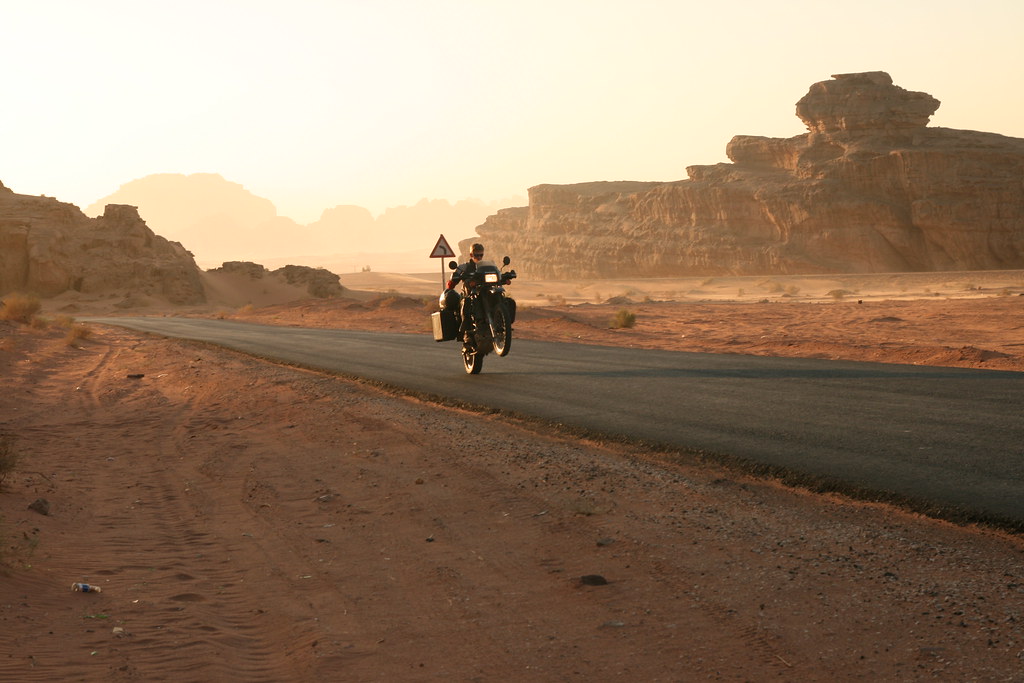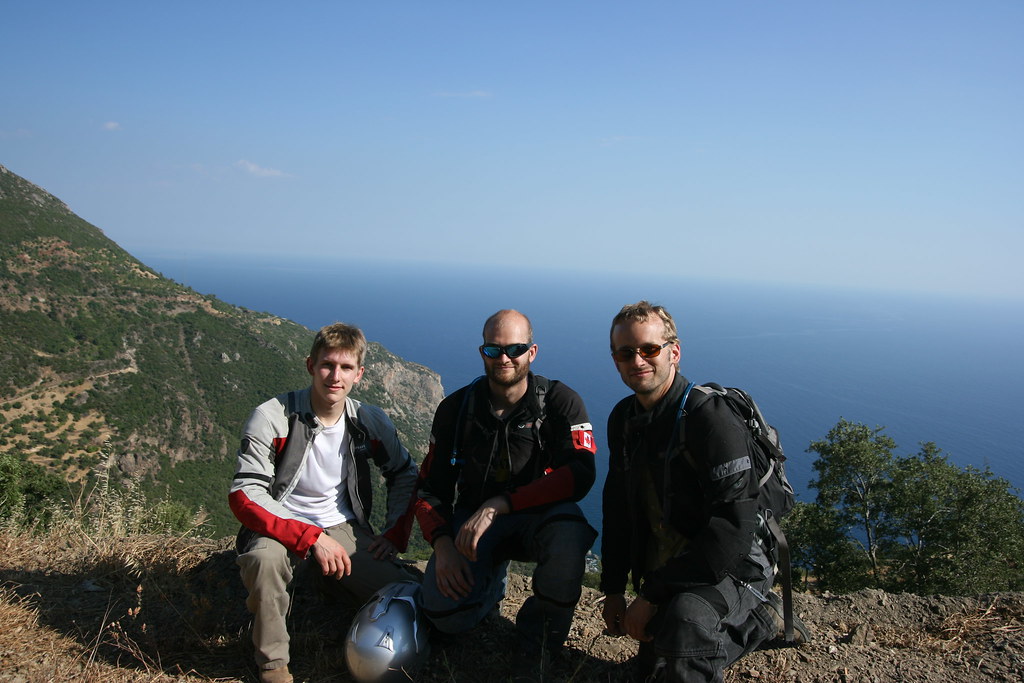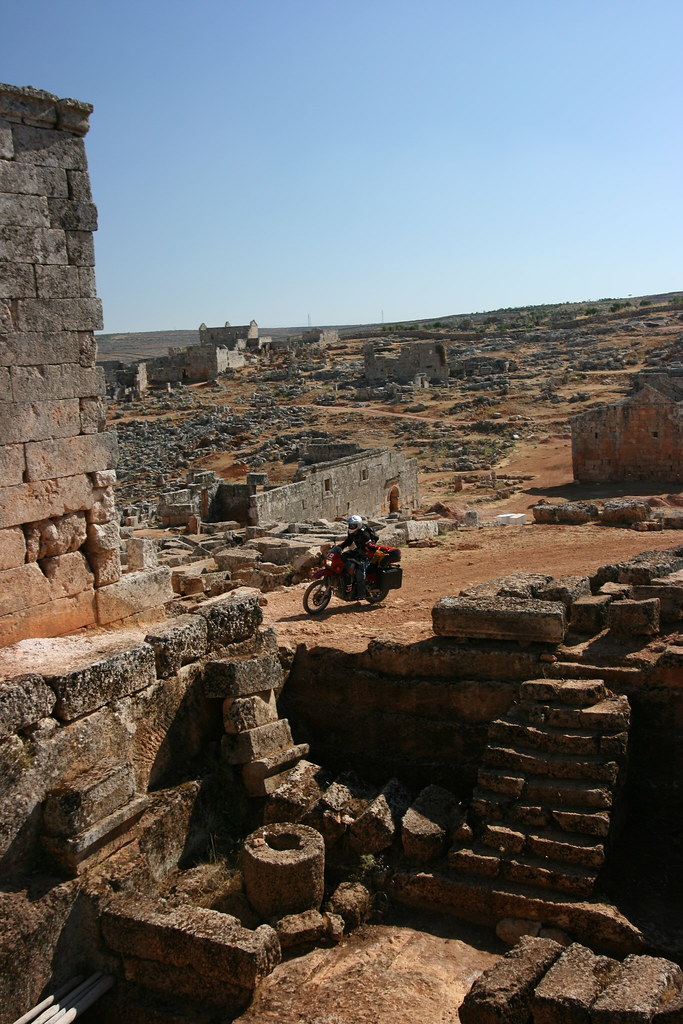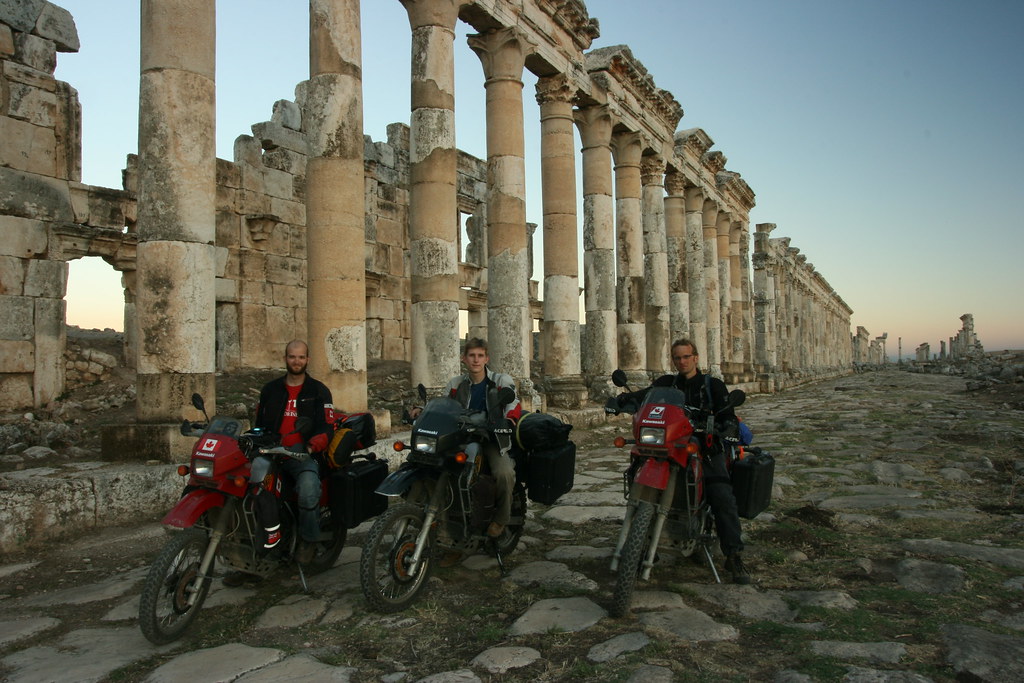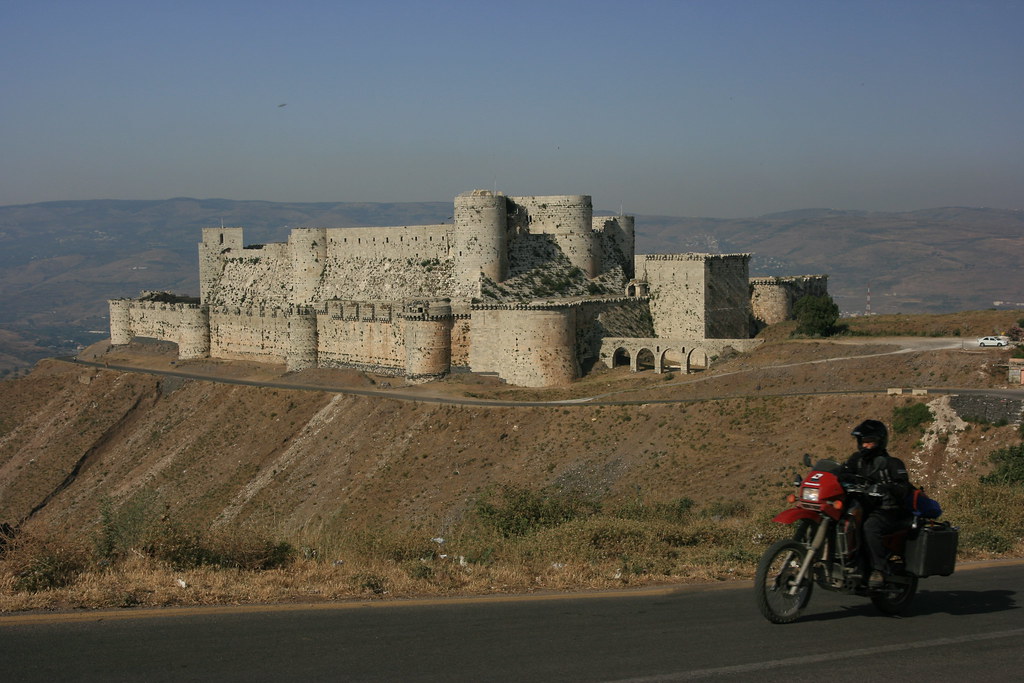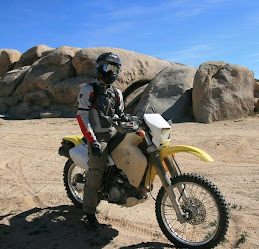To say that the last few days have been eventful is probably an understatement. We've been on a tight schedule and had much to accomplish. In just under a week we had to get the bikes serviced, tyres changed, get me a Sudanese visa and replace some of the countless items that we've lost during the last month. We managed all of that during one manic day in Cairo. See Tyson's blog for an entertaining account. But we had another mission to accomplish too - that was riding the 1000km from Cairo to Aswan to catch the ferry to Sudan. The ferry only leaves on Mondays. Miss it and we faced a week-long delay.
Thursday - A lesson in bargainingSetting off from downtown Cairo early on Thursday morning, the streets were surprisingly quiet and cool. A welcome change from their normal manic state (filled with tooting cars and suicidal pedestrians). In such mild conditions it didn't take us long to get to Giza and catch our first glimpse of the pyramids.
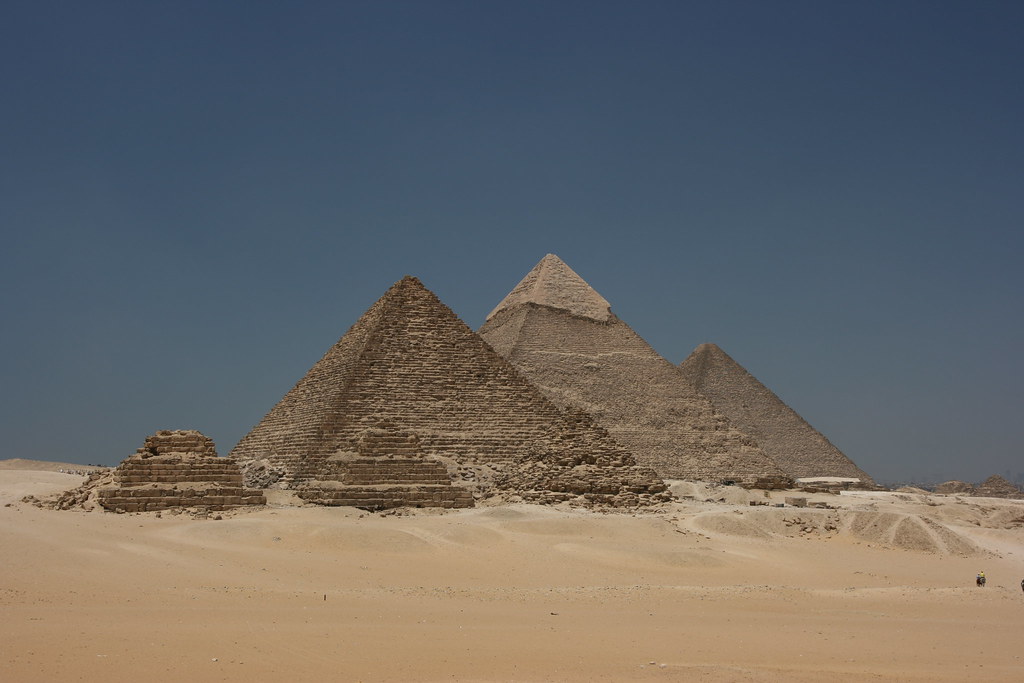
Unlike the photos would have you believe, the pyramids aren't actually in the middle of the desert. Cairo has expanded to such an extent that its suburbs reach right up to the edge of the pyramids and beyond. Only the south eastern quadrant of the site is kept as desert, and that's where the majority of photos are taken (the one above included).
Riding up to the historic monuments we were greeted by a local tour guide - a tall thin man dressed in traditional arabic clothing. He introduced himself as Emad, and explained that he could give us a tour of the pyramids. When we asked how much it would cost he simply said - "when I've made you happy, you can make me happy" - implying we should give him a decent tip at the end. Still unsure of what a decent tip actually amounts to in Egypt, we were a little uneasy, but decided to accept his vague offer anyway.
Emad explained how there were actually 9 pyramids of giza, the three larger pyramids and 6 smaller ones built for the Pharaohs' wives. In order to see all nine in their splendor we needed to ride out into the desert. That was fine with us - we'd been planning to get some photos of us riding our bikes in front of the pyramids anyway. But Emad explained that only two methods of transport were allowed in the desert: camels and horses. Walking wasn't even allowed, giving the tour guides a cosy monopoly over the entire site.
A camel seemed like a much less appealing option than our motorcycles, but with no choice we agreed to the tour - after all, how often do you get to see the pyramids? Foolishly though we didn't negotiate the price. Emad said it was 180 Egyptian pounds per person for an hour-long ride (about 18GBP) and so, like a bunch of schmucks, that's exactly what we paid. Only a few days later did we discover that the going rate for a camel ride is more like 20EP. Score one for Emad.
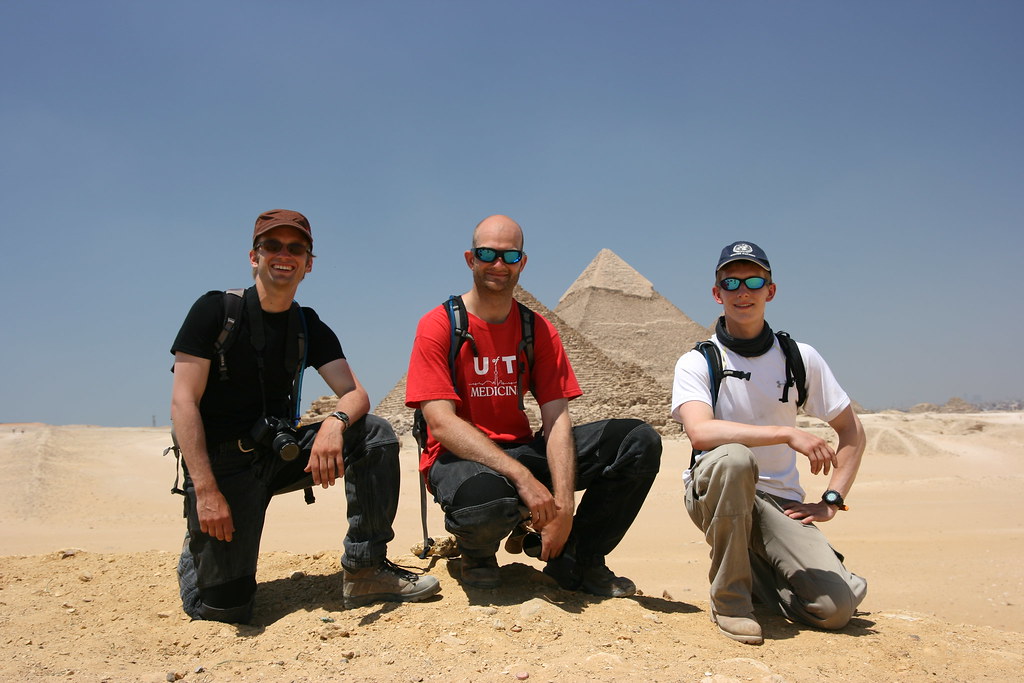
The novelty of riding a camel soon began to wear off - replaced by a distinct sense of chafing on the backside. So, after snapping the standard photograph of the pyramids I amused myself by finding out a bit more about my dromedary friend - Moses the Camel. He was a bit of a grumpy chap, grunting and groaning every time he had to get up and down. (Incidentally, the way to get a camel to sit is to make a hacking noise like you're clearing your throat. Saying "sit Moses" is less effective.)
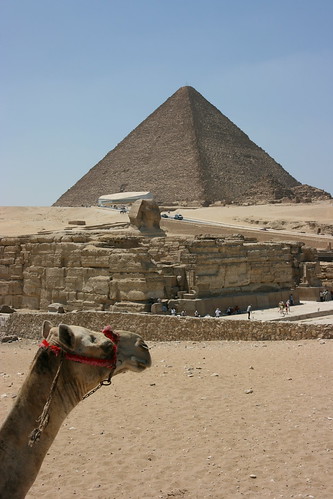
According to Emad, the average camel costs about 30,000EP or 3000 GBP, which is the same price we paid for our bikes. I briefly consider trading in my KLR 650 for a camel, thinking that sand riding would be much easier. But when I discover that camels can only run at about 30mph, I decide that it would probably take too long to reach Cape Town. Camels smell too.
To round off our camel tour, Emad took us to a papyrus and perfume museum. 'Museum' is a euphemism if ever I've heard one. The building was actually just an ornate shop - one of hundreds that are dotted around Cairo. We were ushered in and immediately given a drink as part of the owner's 'Egyptian hospitality'. The owner dramatically threatened to slit his throat if we refused, so we knocked back the cool drinks while he led us around the store. We were shown how papyrus was made and were told several stories that were depicted in some of the craftwork. But we were less than interested, and with time ticking away Tyson started getting frustrated. Seeing that we were moving toward the exit, the owners pulled out all the stops to try and keep us in the store. They tried showing us books of endorsements from other tourists who had shopped there, then a list of international firms that they had supplied papyrus and perfume with, they even offered us discounts. But we were wise to the scam - I had fallen for it the previous day while shopping for a birthday present for my sister. So we made our excuses and walked defiantly out of the store. Score one for us.
Back on the camels, we bounced our way past the Sphinx (which was much smaller and distinctly less impressive than I'd expected) and made our way back to the bikes. I was relieved to get off Moses and was looking forward to getting back on my bike and out of Cairo. During the short while we had spent in the city I had felt like a very obvious tourist - out of place and a clear mark for all the street vendors. I got the distinct impression that every time I bought something (with the exception of an ice cream for 20p) I had overpaid. Not a pleasant feeling, but a learning experience. I'm used to fixed prices and only haggling on certain deals - like buying a motorbike. But in Egypt it seems that almost every price is up for negotiation. It's like a game and one that the locals are very skilled at. From what I have learned, the trick is to dispense with your English sense of politeness and freely offend the vendor by offering a ridiculously low price. Only then will you settle on something sensible. Also, as we found out at one restaurant in Cairo - negotiate the terms of your deal up front, otherwise you risk receiving an unpleasant shock when the bill turns up.
Almost free of the city, Emad made one last attempt to get us to stay a little longer by offering a tour of the Pyramids of Saqqara - a quieter site just 25km away. I was still keen to move on, but the promise of riding our bikes through the desert in front of some pyramids was enough to convince Tyson and Jerry to accept. Learning from our previous mistake, this time we negotiated the price. Starting at 300 Egyptian Pounds per person, Tyson haggled Emad down to 250, which given what we'd paid for the camel ride earlier on (our benchmark for a fair price) seemed reasonable. In hindsight though, we'd been taken to the cleaners once again. 2-1 to Emad.
As part of the deal it emerged that Emad and his young helper Salouma would have to ride on the back of our bikes. Carrying a passenger is not an enticing prospect when riding through deep sand. And I drew the short straw, having to take Emad on the back of mine. Jerry got Salouma and Tyson escaped unhindered (lucky bugger).
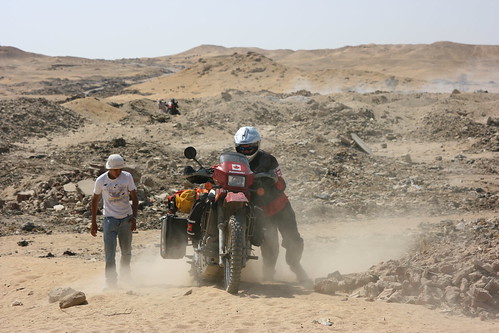
With Emad shouting directions, we passed through back alleys, sandy trunk roads, and a rubbish tip before finding the desert. The heavily loaded bikes snaked wildly in the deep sand, sending us tumbling off a number of times. Hot, bothered and with sand in places I daren't describe, we reached the shaded camp of Saqqara with an enormous sense of relief. Tyson and I arrived together, and pulled over to wait for Jerry. After a few minutes there was still no sign, so I traipsed back to find out what had happened.
I didn't have to go far before I saw Jerry and Salouma staring at Jerry's bike on its side. The bike looked alright, but it couldn't engage gear. I figured that we might be able to get it going if we got it onto flat ground and bump-start it. That meant pushing the bike about 400m through deep sand. An exhausting prospect to say the least. But together we just about managed it. Sadly though, a bump start wasn't sufficient. The only alternative was that Jerry had burnt his clutch out. Something we didn't have the parts or technical know-how to fix.
At this point, we were already a few hours behind schedule and our chances of making the Aswan ferry on Monday were looking increasingly slim.

But, with business out of the way, Emad transformed in to a different person. It seemed like he felt partly responsible for the damage to Jerry's bike, and so, after a quick tour of the pyramids, he arranged for a truck to take Jerry's bike to a local mechanic. He spoke firmly to the mechanic, and relayed back to us that the mechanic could fix it for 700EP. The only difficulty was finding the parts. The price seemed quite expensive, but with few other options we agreed - and the mechanic sent out runners to scour the streets of Cairo looking for replacement clutch plates.
In the meantime, Emad graciously invited us to stay at his home "as his brothers". Keen to learn more about the culture and worried that we wouldn't be able to find the mechanic without Emad's help, we accepted his generous offer. He told us to treat his house as if it were our own, so within the hour we were showered and sitting down to a delicious meal of camel stew.
Over dinner, Emad played an excellent host, serving drinks and asking us what we would like to do in the evening. He suggested a night ride in to the desert to see the light show at the pyramids. Taken aback by his generousity we all nodded in agreement - it sounded like an excellent idea. And it was. We had an unforgettable time riding through the desert on horseback galloping past the illuminated pyramids.
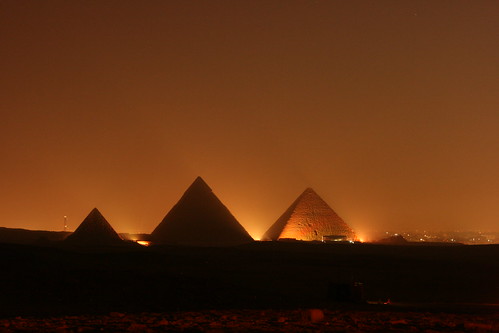
Returning late to Emad's house, we were treated to another large meal of camel stew. This one was prepared by his brother, rather than his wife, and wasn't quite up to the same standard. There was plenty of gristle and the odd bit of cartilage. But we still enjoyed it. It was past 2am by the time we finished and our eyelids were heavy. Before turning in, Emad suddenly switched back to business mode again. He told us that he would only charge us 400EP for the night ride - the rate he reserves only for his friends. This surprised us. We'd thought the night ride was part of his generous hospitality. But sitting there in his home having been fed and watered, we were powerless to object, so we each nodded quietly in agreement. Then he adds the words 'per person' and we realise we've been completely shafted again. A real shame, and a bitter way to end an otherwise thrilling day.
Friday - Our education continuesWe woke up early after a short night's sleep on Emad's floor. With business seemingly out of the way, Emad was all smiles again and was back to being the perfect host. He served us some sweet milky tea for breakfast and then arranged for a private car to drive us back to Cairo to visit the Egyptian Museum. We enjoyed a pleasant morning whittling away the hours researching clutches on the internet and exploring the countless artifacts, mummies, and sarcophaguses in the museum. It's a fascinating place and would take days to take it all in. The unquestionable highlight was the Tutankhamun exhibition - artifacts from which have been displayed all over the world. I'm particularly thrilled to see King Tut's mask, as it reminds me of a project I did back when I was in primary school. Happy memories.
Back at Emad's apartment we spend the afternoon chatting with our host learning about his business and his life. He's 28 and has been working at the pyramids for 19 years. In that time he's learned to speak half a dozen languages and is always learning more. He seems very proud to be an Arab and signs up to all that involves. Women have a secondary role in his culture and it shows. He is a loving father, but clearly dotes over his son more than his daughter.
We also learn of his business. We find out that the pyramid area is controlled by 13 bosses, one of whom Emad works for. Each kingpin owns a tourist license, camels and horses, and so commands a large proportion of every deal made at the site. Working for each of the bosses are half a dozen guides like Emad, and working for them are helpers - boys as young as eight who will grow up to become guides. With so many people to pay off, Emad only receives 5% of his deals and makes most of his money out of his tips.
This knowledge changes our view of Emad again. Before, we were planning to be stingy with his tip - as payback for being tricked so many times before. But seeing that most of those funds would end up with the kingpin, we felt like we still owed Emad for his hospitality.
Moreover, Emad continued to be extremely helpful throughout the day. Constantly calling the mechanic to check on progress. When it emerged that the mechanic was stalling for time, Emad took one of the burnt clutch plates to another mechanic to get him searching for them as well. But with the searches proving fruitless we decided we needed a contingency plan - to ship a new set of clutch plates directly from Canada. Arranging for the Canadian shipment turned out to be a smart move as it gave us some bargaining clout later on. Over dinner (not camel for a change) when the conversation switched back to business Emad told us that the second mechanic had found the parts but wanted 2400EP for them - a small fortune and four times their true value. We balked at that price and it quickly slipped to 1700EP. But even that seemed very steep. And with the original mechanic still coming up empty, we decided it would be more sensible, cheaper and safer to wait for the parts from Canada. Sure we would miss the ferry, but better that than rushing all the way to Aswan on potentially dodgy and overpriced parts.
When we'd made that decision things changed remarkably fast. We were quickly taken back to the original mechanic to pickup Jerry's bike. Emad was still hopeful that he might have found the parts. And sure enough when we arrived, the grubby mechanic was grinning with eight shiny new clutch plates in his hand. Apparently he had just been 'joking around' when he said he couldn't find any. He also said he would do all the repairs for 1000EP - just 300EP more than he originally quoted. In the car on the way over, we had discussed the absolute maximum we would be willing to pay if such a situation had occurred. 1000EP was the figure we had come up with. No coincidence there.
We agree to the deal, but are convinced that Emad has been doing some double dealing. Another good example of how Egyptians think on their feet to get the most out of every transaction.
With the mechanic installing the parts on Jerry's bike, Emad took us to his friends wedding up the road. This was one of the stranger experiences we've had on our trip. Sitting inside a blue and pink open top tent surrounded by Arab men, we sat and watched the spectacle unfold. On stage was what could be loosely described as a band, who were compensating for their lack of talent with volume and reverb effect. While trying to tune out the deafening din we were surprised to see that there were no women present. A stark contrast to a western wedding. One lady did turn up later in the evening, but she was dressed in provocative clothing (by Arabian standards) and presumably wasn't there for the fun of it. Just before heading off, we witnessed the most bizarre spectacle of all - a startled horse being lead through the tent with a chubby baby on its back dressed as a Sheikh. No explanation was offered, further adding to our sense of amusement.
When we returned to the mechanic we were greeted by a welcome sight - Jerry's bike in full working order. Seeing Jerry test it out made me realise how much I'd been missing riding and how much I was looking forward to getting out of Cairo and getting my freedom back.
We returned to Emad's apartment and Jerry parked his bike next to ours. It was nice to see the three mules back together, appropriately parked in the stable area under Emad's apartment. Before turning in, we finished our business with Emad. Despite all the problems and potential double dealings we decided to hand over a generous 1000EP tip. No doubt too much, but he had bee helpful, and we figure it was better to see his family with a bit more money than to be satisfied that we got a good deal.
Saturday - One setback too manyThe burnt clutch fiasco had put us two days behind schedule. In order to make up the ground and catch the Aswan ferry we needed to ride 1000km from Cairo in just one day. A tall order but just about doable.
We got up at 5am after a couple of hours sleep - the third night in a row that we'd had less than 5 hours. I'm exhausted and my allergies are acting up.
On the highway we're all struggling with our new off-road tyres, which wobble at high speed. The effect on my bike is particularly bad, accentuated by the vibration in my frame which developed earlier on in the trip. To ride safely we have to keep our speed under 100kph - further adding to the time pressure.
In my sleep deprived state on wobbly tyres the experience closely resembles driving drunk and I beckon to the others that we should pull over. In Al-Fayuum, 100km south of Cairo, the guys wander off to grab an Arabian coffee and I try to find a quiet corner to catch forty winks. No such luck. The locals prove too curious and I end up having to answer questions about our trip instead.
Back on the road, Jerry is leading and we're struggling to find our way back to the highway. Heading south in an effort to intercept it, we pass through a number of small villages. As in Mexico and Guatemala these were marked by a series of speed bumps (or topes) which force you to slow down as you go through. Fail to spot them and you face a nut-busting incident at the very least. At one of these bumps Team Canuk suffered its most serious setback since we left London - Jerry came off his bike.
Trying to slow down to avoid the speed bump, Jerry slammed on his brakes, sending his bike into a sideways skid. He passed over the bump with his bike at an angle and his slippery back tyre spun out, sending him crashing to the floor. The crash seemed to happen in slow motion right in front of us. As the bike hit the floor it sent a cloud of dust in to the air, and started spinning slowly around. The bike - being much heavier than Jerry - slipped away from him and ground to a halt some 40m down the road, facing back the way it had come. Jerry skidded to a halt a few metres earlier.
As I pulled over, Jerry was already trying to stand up, but after taking two steps his left leg gave way and he collapsed to the floor in a shriek of pain. Tyson was quickly at his side and together they diagnosed what the injury was. A knock to the knee had weakened it and had certainly ended any chance we had of reaching Aswan that day. With Tyson tending to his patient I tended to mine - picking up Buffy (Jerry's bike) and wheeling her to the side of the road. Other than a severely scratched pannier, she was in good shape. Unfortunately, the same couldn't be said for Jerry who was clearly in agony and irritated with himself at the crash.
I did my best to help out, getting medical supplies and offering the occasional bit of common-sense advice, but the moment was Tyson's. Acting like a fully trained doctor he gave Jerry a very thorough examination, cleaning up the wound and bandaging it. Good work Bone.
Jerry was adamant that he wanted to keep riding, but Tyson prescribed a few days of rest. I concurred with Dr Brust. Riding in these conditions was hard enough with all four limbs - trying to ride with no left leg would only result in more spills and potentially more injuries.
With Jerry reluctantly convinced, we put his bike on the back of a pickup truck (for the second time in three days), and arranged for a local to drive us to the nearby town of Bani Suef. Along the way we were stopped at a police checkpoint and assigned an escort. Driving off behind the cops, I noticed that Tyson wasn't following. I looped back to find that he had an electrical problem, which had disabled Rosa (Tyson's bike). Tyson quickly found the problem (dusty fuses) and was soon back up and running - but for a brief period my bike was the only one still working.
Our police escort was overly cautious - not wanting Jerry's bike to fall off the bumpy truck - so it took us over an hour to drive the 40km to Bani Suef. But it was with a great sense of relief that we arrived outside the Semeramis Hotel. And, after we'd carried Jerry up to our room on the third floor, I took a minute to catch those forty winks. Seven hours later, I woke up to find Tyson had taken Jerry to hospital, got an x-ray and heroically carried him up two flights of stairs by himself. Again, good work Bone.
Before dropping off for another 8 hours of sleep I took a moment to think about the trip. Assuming we catch the next ferry on Monday the 14th we'll have about 51 days to get to Cape Town. That's three days less than the Long Way Down boys and they had two trucks full of spare parts and a mechanic. But hey - if everything went smoothly this wouldn't be an adventure now would it.
Until next time.
